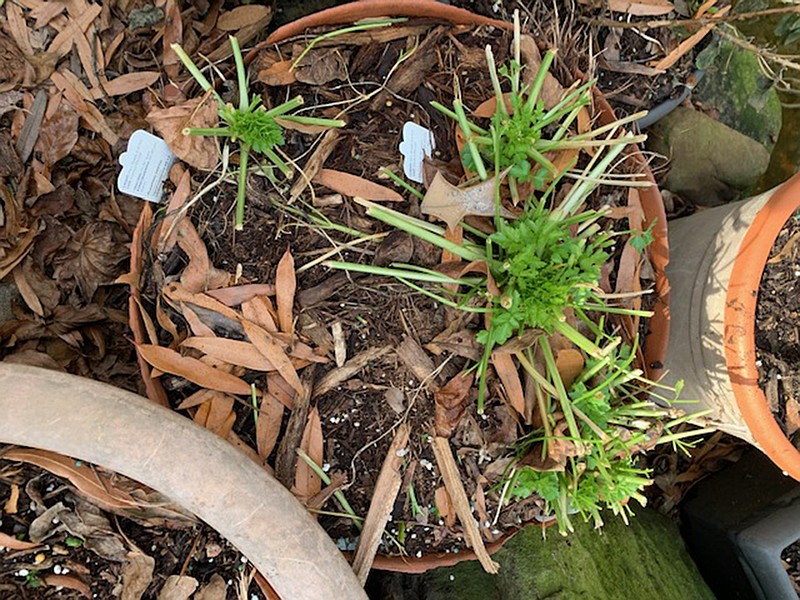Q I had plants growing in containers in my patio garden until something started eating them. Now all I have left are spikes. Favorites were my parsley, rainbow chard, red cabbage, parsley and pansy plants. I live downtown in the Quapaw Quarter and have a high fence around my patio where the containers are located. I have never seen anything eating the plants. I do have squirrels and birds in the patio. Help! What can I do? The parsley and chard are trying to grow back, and I'd like to protect them. I'd also like to plant lettuce and spinach but don't want the plants destroyed. Please tell me what I can do.
A While I can't be 100% certain, my guess is rats. We have had more rat questions this year than ever before. Rats typically come out after dark. You can put a trap out and bait it to catch the culprit. If you lived where deer roam, deer would be a contender. Raccoons and possums can also be in neighborhoods, but they usually do more damage to the pots. You might consider getting some form of netting or covering to keep your plants safe. I had a similar problem on my fig tree, and the bird netting worked wonders. For small pots, you might consider building a small frame around them. Remember that rats can get in small spaces, so you would need a fairly small mesh. Good luck.
Q Last fall, my daughter and son-in-law bought a house with a lovely garden site. The plant in the photo is in the garden. Can you identify it, please? If it's just a big weed, what should be done to get rid of it?

A It looks like a giant mullein, Verbascum. The plant is a biennial. The first season it forms the large rosette of foliage, then the next year (this year) it should produce a spike in the center with yellow blooms. After that, the mother plant dies; but often babies appear around the base.
Q I have started a so-called hobby having to stay home with this virus. I have managed to find some lovely African violets and transplanted those to a larger pot and had success (after I lost one to overwatering). I would like to start new ones for friends and know about cutting off a leaf and rooting that, but it's a lengthy process. Have googled African violets, and it mentioned you could start them from seed but no instructions how this is done. Could you possibly have any info on how this is done? I would appreciate any help from you.

A If you think cuttings would be slow, seeds would be even slower and harder to come by. You would need to order the seeds; and keep in mind, they won't breed true — the resulting plant can look quite different from its parents. African violets actually root rapidly from leaf cuttings. I would prefer to root them in soil, but many gardeners like to put the cuttings in water, to watch them root. I think you end up with a stronger plant if you root it in soil. You should have a small plant to share within a couple of months. Or, if you want to speed up the giving, give the friends some leaf cuttings and let them do the rest.
Q I have a lovely Zephirine Drouhin rose that has been healthy for many years except that it is very susceptible to black spot. Each year it has gotten worse so that the last two years it has had almost no foliage throughout the summer. In spite of that it continues to bloom beautifully. Last year I sprayed with a fungicide (although I had earlier committed to no poisons in my yard) every 10 days. By the end of summer there was some improvement. I am wondering what you think about spraying with a dormant oil in February in hopes that it might get off to a better start in deterring the black spot.
A A dormant oil would kill any overwintering spores on the branches, and it would help you start off the season a bit cleaner, but it won't prevent black spot on the plant during the growing season. The only way to control black spot on susceptible roses in Arkansas is preventative spraying. Begin with a fungicide in the spring as the rose plants begin to leaf out and continue applications all growing season. There are many products labeled for use on roses, and application timing varies by product. Some products need to be sprayed weekly, while others can be applied monthly. Always read and follow the label directions. It is much easier to prevent the disease than to control it once you see it on the leaves.
Retired after 38 years with the University of Arkansas Cooperative Extension Service, Janet Carson ranks among Arkansas' best known horticulture experts. Her blog is at arkansasonline.com/planitjanet. Write to her at P.O. Box 2221, Little Rock, AR 72203 or email [email protected].

